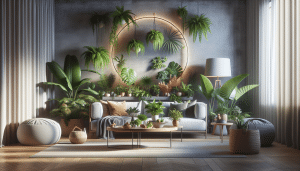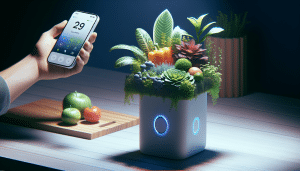Hidden Benefits of Indoor Plants for Your Home
Henry King September 16, 2025
Explore how indoor plants can transform your living space with practical health and design benefits. Discover expert tips on plant care, air purification effects, and ways to create a vibrant, refreshing home environment using accessible greenery.
Why Indoor Plants Matter in Modern Living
Bringing lush, green indoor plants into your home is more than a simple décor decision. Many people now explore indoor plants not just for their soothing visual appeal, but for their ability to impact stress relief, productivity, and even air quality. Plants such as snake plant, pothos, and peace lily have emerged as favorites in urban spaces, often helping to counterbalance the challenges of fast-paced, modern lifestyles. They add calmness and life to rooms that would otherwise feel sterile or empty. In fact, simply having foliage visible from your workspace or living area can provide a daily mental refresh that’s hard to quantify but easy to appreciate.
Today’s homes are often tightly sealed for energy efficiency, which can lead to a build-up of indoor pollutants. Research has shown that certain low-maintenance indoor plants can absorb toxins such as formaldehyde, benzene, and trichloroethylene from the air through their leaves and root systems. This natural air purification process is why many hospitals, schools, and offices incorporate greenery throughout their designs. The experience of caring for these plants, watering and watching them grow, also tends to boost a sense of well-being and accomplishment. It’s a sustainable habit—one that brings ongoing rewards throughout the year.
There is something uniquely satisfying about coming home to a space that feels alive and fresh, instead of static. The versatility of modern houseplants means there are options for every level of experience, from resilient succulents to moisture-loving ferns. Even apartment dwellers with limited light can enjoy healthy greenery by selecting shade-tolerant species. Combining and arranging different varieties, or placing them in decorative containers, allows for endless creativity in every room. The presence of plants in the home continues to demonstrate lasting value, encouraging mindfulness and offering daily moments of connection with nature.
Improving Air Quality with Strategic Plant Choices
Recent studies by reputable organizations reveal that indoor air pollution can cause a range of health issues, from headaches to asthma symptoms. Introduce indoor plants as a strategic solution, as they are natural air cleaners. Peace lilies, spider plants, and bamboo palms are frequently highlighted for their ability to filter out toxins and contribute to healthier, breathable air. Even with a modest number of plants, rooms can benefit from less mold and airborne dust, thus reducing the overall pollutant load within your living environment.
For those sensitive to dust or allergies, the right selection and placement of houseplants can make a measurable difference. Plants act as living humidifiers by releasing water vapor as part of their transpiration process. This subtle increase in humidity can be especially beneficial during cold or dry weather, when artificial heating can strip moisture from the air. Experts often recommend placing a group of plants together in living rooms, bedrooms, or near home offices for an amplified effect on air quality and comfort.
Not every plant cleans air pollutants equally, and the space required for noticeable improvements varies. NASA’s Clean Air Study identified certain species with a particularly strong impact, which has inspired many to experiment with different combinations of plants for best results. Potting mix, watering habits, and ventilation all interact with a plant’s ability to purify air. With a little research and observation, anyone can craft a custom selection that enhances both health and home aesthetics without complicated upkeep.
Wellness Advantages of Living with Houseplants
The wellness movement has embraced biophilic design, which integrates nature directly into everyday spaces for mental and physical benefits. Houseplants play a leading role here—connected to improved mood, lower blood pressure, and greater overall satisfaction at home. Gardening activities, even at a small scale indoors, have proven to decrease cortisol levels and help people unwind from daily stress. This makes plant care a personalized form of at-home therapy that requires no subscription or large financial investment.
More than just pretty scenery, the act of tending indoor plants requires mindful attention. Regular watering, pruning, and adjusting lighting conditions teach patience and routine. Families often find plant care to be a gentle way of teaching children about responsibility, the cycles of life, and the rewards of nurturing living things. Research from various academic institutions shows even brief, daily interactions with greenery can reduce feelings of isolation and help create positive routines, especially for those who spend long hours indoors.
The calming impact of houseplants extends beyond the mental—there is evidence that rooms with indoor greenery lead to better sleep, particularly when aromatic plants like lavender or jasmine are included in bedrooms. Some employers have noticed improvements in productivity and job satisfaction when offices include plant installations. These ripple effects continue to influence how people view and use indoor greenery, and more renters and homeowners now prioritize spaces that can support vibrant, healthy plant collections.
Decor and Style: Integrating Greenery Into Every Room
Modern design trends celebrate the integration of natural elements for both comfort and visual appeal, and houseplants offer a flexible medium for any decorating style. Hanging planters, wall-mounted pods, and tiered plant stands make use of vertical space, while larger floor plants can draw attention to corners or entries. Colorful foliage like crotons or the patterned leaves of calathea add a playful accent, while trailing plants soften abrupt lines and surfaces. There’s virtually no limit to how houseplants can be expressed in a personalized way.
Bathrooms, kitchens, and even hallways can benefit from the thoughtful addition of greenery. Moisture-loving varieties such as ferns, pothos, or heartleaf philodendron often thrive in the humidity of bathrooms. Meanwhile, sunny kitchen windowsills provide ideal conditions for fresh herbs—doubling the benefit by supplying flavor for meals and pleasant aromas. With an ever-expanding selection of decorative planters, terrariums, and macramé plant hangers, your approach can truly reflect your unique personality and needs.
Houseplants bring softness and balance to rooms dominated by electronic gadgets, dark furniture, or industrial designs. When choosing where to place a plant, take into account the available sunlight and airflow for optimal growth. If a space has low natural light, consider resilient options like ZZ plants and mother-in-law’s tongue. For flexible style, move smaller plants seasonally, grouping them for dramatic effect or spreading them out for subtle green touches throughout the home. This organic way to decorate offers ever-changing inspiration.
Essential Tips for Successful Indoor Plant Care
Successful indoor plant care starts with understanding the basic needs of your selected species. Most houseplants thrive on a balance of light, water, and proper soil nutrition. Start by matching a plant’s light requirements—some need plenty of direct sunlight, while others grow well in shaded spots. Watering schedules also vary, with succulents needing infrequent but deep watering, and tropical plants preferring consistent moisture. Using pots with drainage and fresh potting mix can avoid common problems like root rot or stunted growth.
Fertilizing houseplants periodically ensures they continue to produce lush growth and resist pests. Look for specific fertilizer blends suited to each plant type, and avoid overfeeding, which can harm roots. Regular dusting or wiping of leaves is recommended, as cleaner leaves absorb sunlight more efficiently and reduce pest risks. Pruning dead or yellowing leaves and rotating pots to encourage upright growth will further support healthy, attractive plants for the long term.
If challenges arise—such as pest infestations or wilting—tackle them early with non-toxic treatment options and by checking environmental factors like humidity and temperature. Many local garden centers and online resources offer guides for troubleshooting common plant issues. Keeping a simple journal or plant-care app can help track what works in your unique indoor conditions, celebrating small victories along the way. Over time, this hands-on learning brings deeper satisfaction and helps turn plant care into a stress-relieving daily ritual.
Creative Uses: Beyond Decoration and air Quality
Many people don’t realize that indoor plants offer far more than air filtration and aesthetics. Culinary herbs like basil, mint, and chives can be grown in kitchen nooks, bringing both fragrance and fresh flavors to meals. Flowering houseplants such as African violets or begonias offer colorful blooms year-round, and succulents or cacti require little attention but create eye-catching displays. In some cases, specific plants may also provide modest noise-dampening effects by limiting sound reflection, enhancing overall home tranquility.
DIY enthusiasts can use plant clippings or propagations to expand their indoor garden or share with friends. Arranging mini-gardens in glass vessels, also known as terrariums, has become a creative hobby for many, combining art and horticulture in compact spaces. Schools, offices, and health care settings increasingly recognize the power of interactive green spaces not just for beautification but for social and educational benefits as well. Projects like community plant swaps further encourage engagement with greenery in fun and accessible ways.
The connection between people and plants continues to evolve, bringing newly discovered joys and advantages. As more research highlights their positive impacts on mood, productivity, and health, home gardeners and first-time plant owners alike are exploring fresh ways to incorporate greenery. The result: a more vibrant, harmonious, and mindful living space that supports all aspects of daily life.
References
1. United States Environmental Protection Agency. (2022). Indoor Air Quality. Retrieved from https://www.epa.gov/indoor-air-quality-iaq
2. NASA. (2019). NASA Clean Air Study. Retrieved from https://ntrs.nasa.gov/citations/19930073077
3. American Lung Association. (2021). How Houseplants Improve Indoor Air Quality. Retrieved from https://www.lung.org/clean-air/at-home/indoor-plants
4. National Institutes of Health. (2021). Influence of Indoor Plants on Health. Retrieved from https://pubmed.ncbi.nlm.nih.gov/30698717/
5. Royal Horticultural Society. (2020). Houseplants for Healthier Homes. Retrieved from https://www.rhs.org.uk/advice/profile?pid=949
6. Harvard University. (2020). Plants and Well-Being Indoors. Retrieved from https://www.health.harvard.edu/mind-and-mood/houseplants-can-boost-your-health







